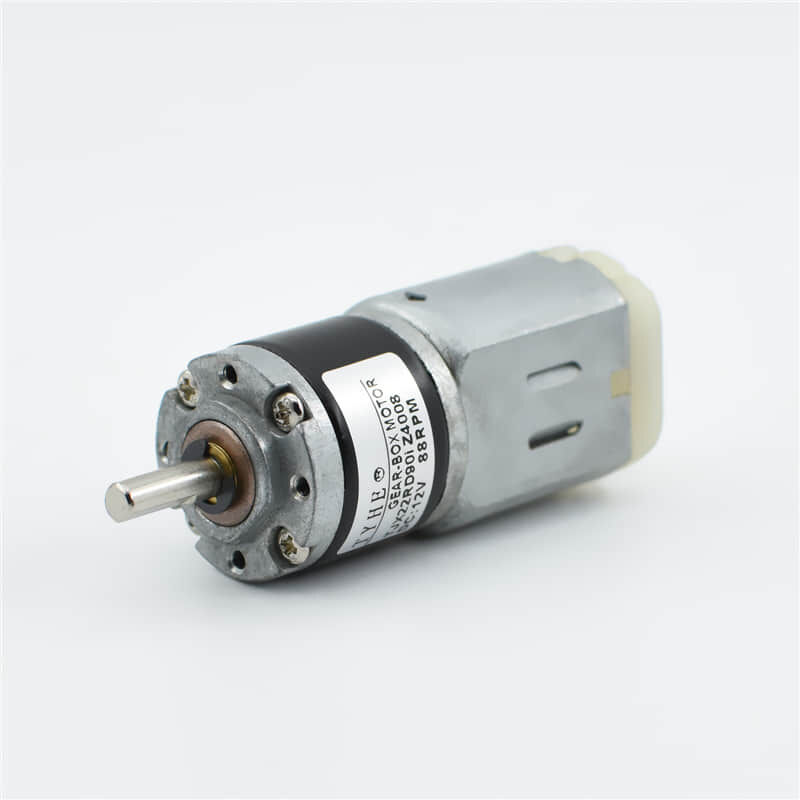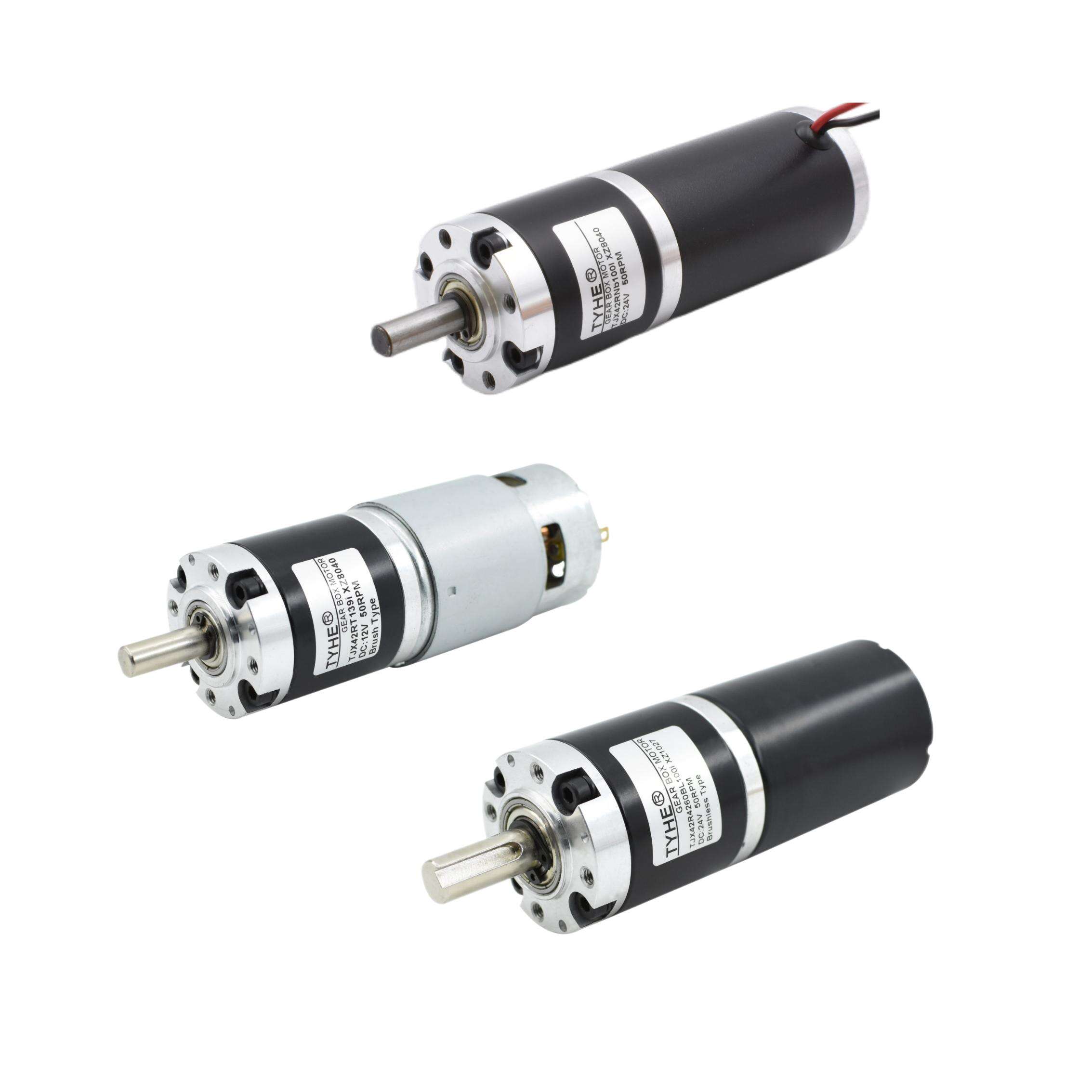Selecting the optimal dc gear motor for your application requires careful consideration of multiple technical factors, performance specifications, and operational requirements. In today's industrial landscape, these versatile components serve as the backbone of countless automation systems, robotics applications, and precision machinery. Understanding the key selection criteria will help you make informed decisions that maximize efficiency, reliability, and cost-effectiveness for your specific project needs.

Understanding DC Gear Motor Fundamentals
Basic Operating Principles
A dc gear motor combines a direct current motor with a gear reduction system to provide enhanced torque output and precise speed control. The integrated gearbox multiplies the motor's torque while proportionally reducing its rotational speed, creating an ideal solution for applications requiring high force at lower velocities. This combination delivers superior performance compared to standard DC motors in scenarios where precise positioning and substantial holding power are essential.
The gear reduction mechanism typically employs planetary, spur, or worm gear configurations, each offering distinct advantages depending on the application requirements. Planetary gears provide compact design with high efficiency, while spur gears offer cost-effective solutions for moderate load applications. Worm gear systems excel in applications requiring high reduction ratios and self-locking capabilities, making them ideal for lifting mechanisms and security applications.
Key Performance Characteristics
Performance evaluation of dc gear motor systems involves analyzing several critical parameters that directly impact application success. Torque output represents the rotational force capability, measured in newton-meters or pound-feet, determining the motor's ability to overcome load resistance and maintain consistent operation under varying conditions. Speed specifications define the operational range, typically expressed in revolutions per minute, with gear reduction ratios affecting the final output characteristics.
Efficiency ratings indicate energy conversion effectiveness, with premium models achieving 85-95% efficiency under optimal conditions. Power consumption directly correlates with operating costs and thermal management requirements, making it a crucial consideration for battery-powered applications or continuous-duty operations. Additionally, starting torque capabilities determine the motor's ability to initiate movement under load, which is particularly important for applications with high static friction or inertial loads.
Critical Selection Parameters
Load and Torque Requirements
Accurate load analysis forms the foundation of proper dc gear motor selection, requiring comprehensive evaluation of both static and dynamic forces within the application. Static loads include gravitational forces, preload tensions, and friction coefficients that resist initial movement, while dynamic loads encompass acceleration forces, momentum changes, and operational variations throughout the duty cycle. Calculating peak torque demands ensures adequate motor sizing with appropriate safety margins.
Duty cycle considerations significantly impact torque requirements and thermal management needs. Continuous-duty applications require motors rated for 100% duty cycle operation with adequate heat dissipation capabilities, while intermittent operations may accommodate higher peak loads with lower continuous ratings. Understanding load profiles helps optimize motor selection for energy efficiency and extended service life while avoiding oversizing that increases costs and space requirements.
Speed and Precision Control
Speed control requirements determine the appropriate gear ratio and motor configuration for optimal performance. Applications requiring precise positioning benefit from high gear reduction ratios that provide fine resolution and improved accuracy, while high-speed operations may require lower reduction ratios to maintain adequate output velocity. The relationship between input speed, gear ratio, and output speed must align with application timing requirements and throughput expectations.
Precision positioning applications often require encoders or feedback systems integrated with the dc gear motor assembly. These components provide real-time position and velocity feedback, enabling closed-loop control systems that maintain accuracy despite load variations or environmental changes. Encoder resolution directly impacts positioning accuracy, with higher pulse counts per revolution delivering finer resolution at the expense of increased complexity and cost.
Environmental and Mounting Considerations
Operating Environment Factors
Environmental conditions significantly influence dc gear motor selection and longevity, requiring careful evaluation of temperature ranges, humidity levels, and contamination exposure. Operating temperature affects motor performance, with higher temperatures reducing torque output and accelerating component degradation. Standard motors typically operate within 0-40°C ambient conditions, while specialized units accommodate extended ranges from -40°C to +85°C for harsh environment applications.
Protection ratings define the motor's resistance to dust and moisture ingress, with IP54 providing basic protection for indoor applications and IP67 offering submersible capabilities for outdoor or washdown environments. Chemical exposure requires specialized seals and materials to prevent corrosion and maintain performance over extended periods. Vibration and shock resistance become critical factors in mobile applications or high-dynamic environments where mechanical stress could damage internal components.
Mounting and Integration Options
Mechanical mounting configurations must accommodate space constraints while providing adequate support for operational loads and vibrations. Flange mounting offers rigid attachment with precise alignment capabilities, ideal for applications requiring accurate positioning and high torque transmission. Shaft mounting provides compact installation but requires additional support structures to handle radial loads and prevent deflection under operational stress.
Output shaft specifications including diameter, length, and key configurations must match driven equipment requirements for proper power transmission. Standard shaft options include plain round shafts, keyed shafts, and splined configurations, each offering different torque transmission capabilities and alignment tolerances. Custom shaft modifications may be necessary for specialized applications or retrofit installations where standard configurations cannot accommodate existing equipment interfaces.
Power Supply and Control Integration
Voltage and Current Specifications
Power supply compatibility represents a fundamental consideration in dc gear motor selection, with voltage ratings ranging from low-voltage 12V systems to industrial 48V applications. Current requirements determine power supply sizing and wiring specifications, with starting currents typically exceeding running currents by 300-500%. Understanding power consumption patterns helps optimize electrical system design and prevents voltage drops that could affect performance or cause premature failure.
Battery-powered applications require careful analysis of voltage discharge characteristics and current consumption profiles to ensure adequate runtime and performance throughout the operational cycle. Motor efficiency directly impacts battery life, making high-efficiency models essential for portable or remote applications where power conservation is critical. Regenerative braking capabilities can extend battery life in applications with frequent deceleration cycles by recovering kinetic energy during stopping sequences.
Control System Compatibility
Modern dc gear motor applications often require integration with programmable logic controllers, motion controllers, or embedded systems for automated operation. Control interface requirements may include analog voltage signals, pulse-width modulation inputs, or digital communication protocols such as CAN bus or Ethernet connectivity. Understanding control system requirements early in the selection process ensures compatibility and optimal performance integration.
Safety features including emergency stops, overcurrent protection, and thermal monitoring enhance system reliability and protect personnel and equipment from potential hazards. Built-in protection circuits can prevent damage from overload conditions, while external monitoring systems provide real-time status information for predictive maintenance and system optimization. The dc gear motor selection should incorporate appropriate safety margins and protection features based on application risk assessment and regulatory requirements.
Cost Analysis and Lifecycle Considerations
Initial Investment vs Long-term Value
Cost evaluation extends beyond initial purchase price to encompass total cost of ownership throughout the expected service life. Higher-quality dc gear motor units typically command premium pricing but deliver superior reliability, efficiency, and longevity that reduce maintenance costs and downtime expenses. Energy efficiency improvements can provide substantial savings in high-duty cycle applications where operational costs accumulate over time.
Maintenance requirements vary significantly between different motor technologies and quality levels, with sealed bearing systems and advanced lubrication extending service intervals and reducing labor costs. Standardization on specific motor families can reduce spare parts inventory costs and simplify maintenance procedures across multiple installations. Volume purchasing considerations may justify selecting slightly oversized units to achieve better pricing while maintaining performance margins for future modifications or increased loads.
Reliability and Maintenance Planning
Service life expectations depend on application severity, environmental conditions, and maintenance practices, with quality dc gear motor systems typically providing 10,000-50,000 hours of operation under normal conditions. Predictive maintenance strategies utilizing vibration monitoring, temperature sensing, and current signature analysis can identify potential failures before they occur, minimizing unplanned downtime and extending equipment life.
Spare parts availability and technical support become crucial factors for critical applications where extended downtime would result in significant production losses. Established manufacturers typically provide longer parts availability and comprehensive technical documentation, while specialized applications may require custom modifications or extended warranty coverage. Service and repair capabilities should align with operational requirements and geographic constraints to ensure timely support when needed.
FAQ
What gear ratio should I choose for my dc gear motor application
Gear ratio selection depends on your specific speed and torque requirements. Higher ratios provide increased torque output and finer positioning control but reduce maximum speed. Calculate your required output torque and speed, then select a ratio that provides adequate torque with 20-30% safety margin while meeting speed requirements. Consider that higher ratios may reduce efficiency and increase backlash, which could affect positioning accuracy in precision applications.
How do I determine the appropriate power rating for my application
Power rating should be based on your worst-case load conditions and duty cycle requirements. Calculate the maximum torque and speed demands, including acceleration forces and safety margins, then select a motor with sufficient continuous power rating. For intermittent duty applications, you may be able to use peak power ratings, but ensure adequate cooling time between cycles to prevent overheating and premature failure.
What maintenance is required for dc gear motor systems
Maintenance requirements vary by motor type and application severity. Sealed bearing units typically require minimal maintenance beyond periodic inspection and cleaning. Lubricated gearboxes may need oil changes every 2,000-8,000 operating hours depending on load and environment. Monitor operating temperature, vibration levels, and current consumption for early indication of potential issues. Keep ventilation areas clean and ensure proper alignment to maximize service life.
Can I use a dc gear motor in outdoor or harsh environments
Yes, but you must select appropriate environmental protection ratings and materials. Look for IP65 or higher ratings for dust and moisture protection, with IP67 or IP68 for submersible applications. Consider temperature-rated motors for extreme conditions, and specify corrosion-resistant materials for chemical environments. Proper sealing and drainage provisions help prevent moisture accumulation and ensure reliable operation in challenging conditions.


